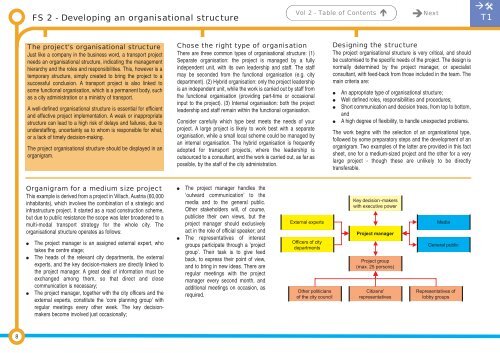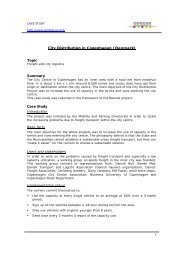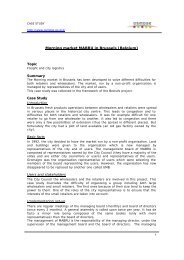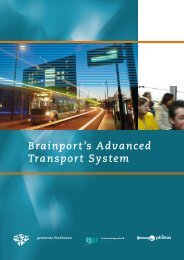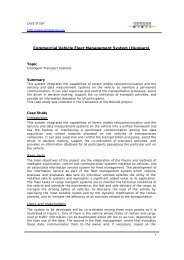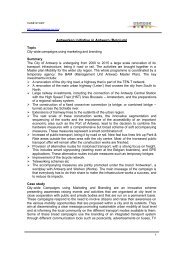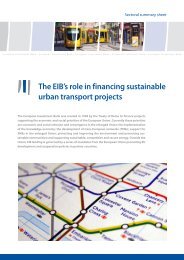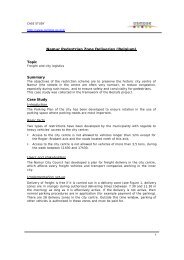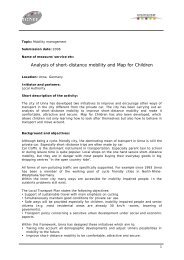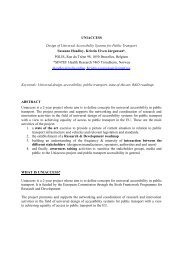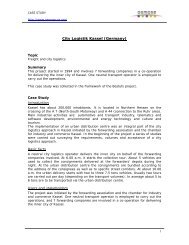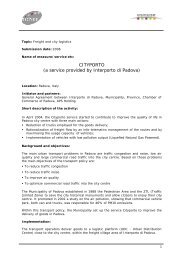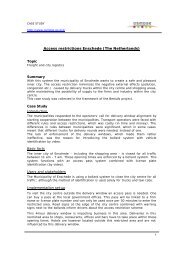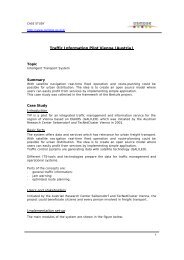Successful transport decision-making - Osmose
Successful transport decision-making - Osmose
Successful transport decision-making - Osmose
Create successful ePaper yourself
Turn your PDF publications into a flip-book with our unique Google optimized e-Paper software.
FS 2 - Developing an organisational structure<br />
Vol 2 - Table of Contents <br />
Next<br />
<br />
T1<br />
The project's organisational structure<br />
Just like a company in the business word, a <strong>transport</strong> project<br />
needs an organisational structure, indicating the management<br />
hierarchy and the roles and responsibilities. This, however is a<br />
temporary structure, simply created to bring the project to a<br />
successful conclusion. A <strong>transport</strong> project is also linked to<br />
some functional organisation, which is a permanent body, such<br />
as a city administration or a ministry of <strong>transport</strong>.<br />
A well-defined organisational structure is essential for efficient<br />
and effective project implementation. A weak or inappropriate<br />
structure can lead to a high risk of delays and failures, due to<br />
understaffing, uncertainty as to whom is responsible for what,<br />
or a lack of timely <strong>decision</strong>-<strong>making</strong>.<br />
The project organisational structure should be displayed in an<br />
organigram.<br />
Chose the right type of organisation<br />
There are three common types of organisational structure: (1)<br />
Separate organisation: the project is managed by a fully<br />
independent unit, with its own leadership and staff. The staff<br />
may be seconded from the functional organisation (e.g. city<br />
department). (2) Hybrid organisation: only the project leadership<br />
is an independent unit, while the work is carried out by staff from<br />
the functional organisation (providing part-time or occasional<br />
input to the project). (3) Internal organisation: both the project<br />
leadership and staff remain within the functional organisation.<br />
Consider carefully which type best meets the needs of your<br />
project. A large project is likely to work best with a separate<br />
organisation, while a small local scheme could be managed by<br />
an internal organisation. The hybrid organisation is frequently<br />
adopted for <strong>transport</strong> projects, where the leadership is<br />
outsourced to a consultant, and the work is carried out, as far as<br />
possible, by the staff of the city administration.<br />
Designing the structure<br />
The project organisational structure is very critical, and should<br />
be customised to the specific needs of the project. The design is<br />
normally determined by the project manager, or specialist<br />
consultant, with feed-back from those included in the team. The<br />
main criteria are:<br />
<br />
<br />
<br />
<br />
An appropriate type of organisational structure;<br />
Well defined roles, responsibilities and procedures;<br />
Short communication and <strong>decision</strong> trees, from top to bottom,<br />
and<br />
A high degree of flexibility, to handle unexpected problems.<br />
The work begins with the selection of an organisational type,<br />
followed by some preparatory steps and the development of an<br />
organigram. Two examples of the latter are provided in this fact<br />
sheet, one for a medium-sized project and the other for a very<br />
large project - though these are unlikely to be directly<br />
transferable.<br />
Organigram for a medium size project<br />
This example is derived from a project in Villach, Austria (60,000<br />
inhabitants), which involves the combination of a strategic and<br />
infrastructure project. It started as a road construction scheme,<br />
but due to public resistance the scope was later broadened to a<br />
multi-modal <strong>transport</strong> strategy for the whole city. The<br />
organisational structure operates as follows:<br />
<br />
<br />
<br />
The project manager is an assigned external expert, who<br />
takes the centre stage;<br />
The heads of the relevant city departments, the external<br />
experts, and the key <strong>decision</strong>-makers are directly linked to<br />
the project manager. A great deal of information must be<br />
exchanged among them, so that direct and close<br />
communication is necessary;<br />
The project manager, together with the city officers and the<br />
external experts, constitute the ‘core planning group’ with<br />
regular meetings every other week. The key <strong>decision</strong>makers<br />
become involved just occasionally;<br />
<br />
<br />
The project manager handles the<br />
‘outward communication’ to the<br />
media and to the general public.<br />
Other stakeholders will, of course,<br />
publicise their own views, but the<br />
project manager should exclusively<br />
act in the role of official speaker; and<br />
The representatives of interest<br />
groups participate through a ‘project<br />
group’. Their task is to give feed<br />
back, to express their point of view,<br />
and to bring in new ideas. There are<br />
regular meetings with the project<br />
manager every second month, and<br />
additional meetings on occasion, as<br />
required.<br />
External experts<br />
Officers of city<br />
departments<br />
Other politicians<br />
of the city council<br />
Key <strong>decision</strong>-makers<br />
with executive power<br />
Project manager<br />
Project group<br />
(max. 25 persons)<br />
Citizens'<br />
representatives<br />
Media<br />
General public<br />
Representatives of<br />
lobby groups<br />
8


